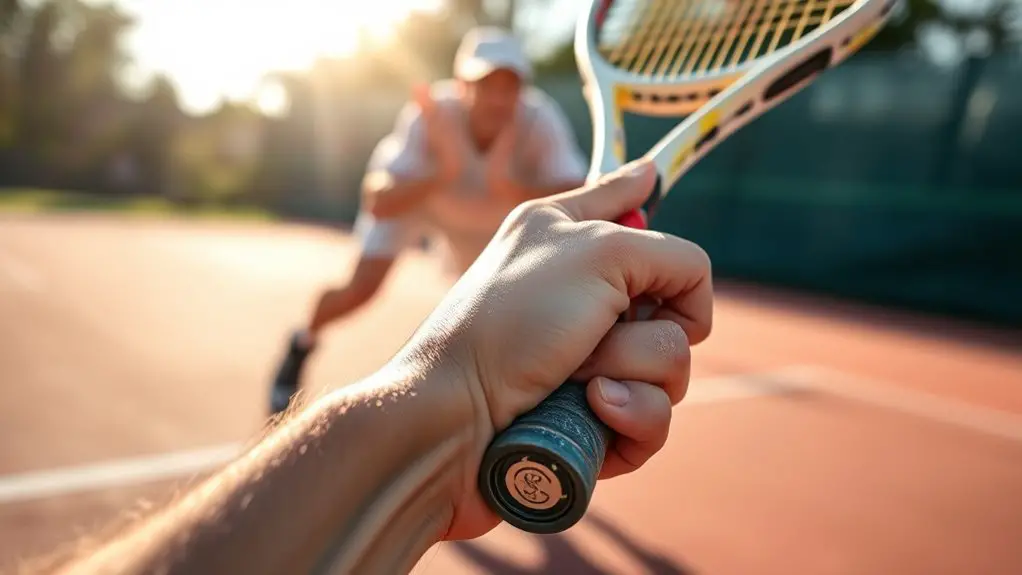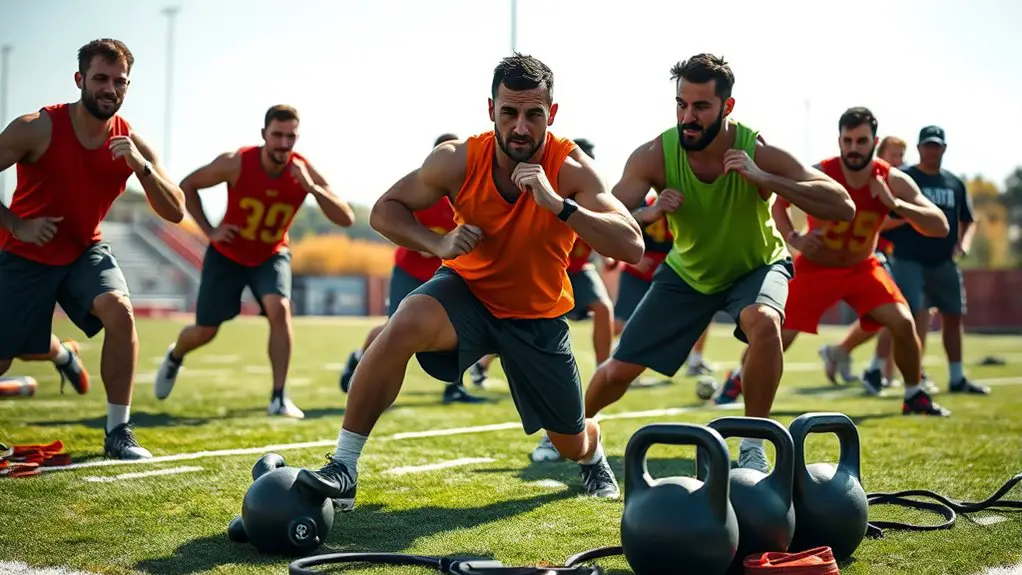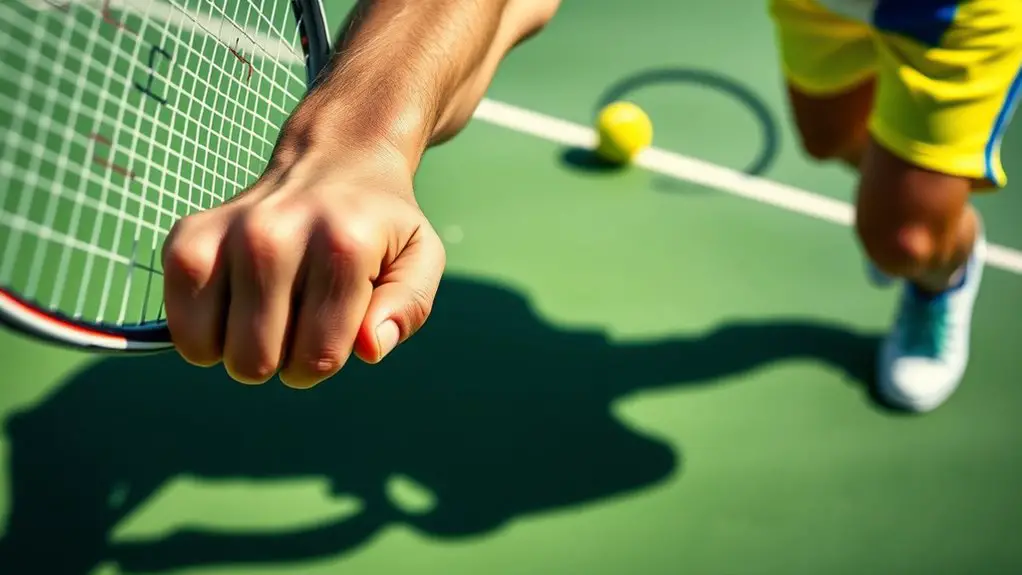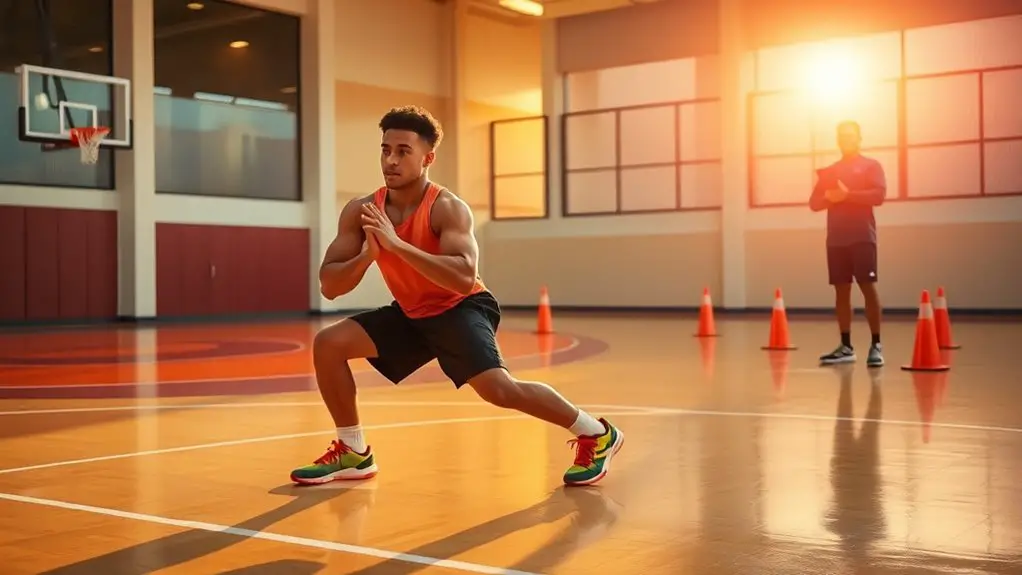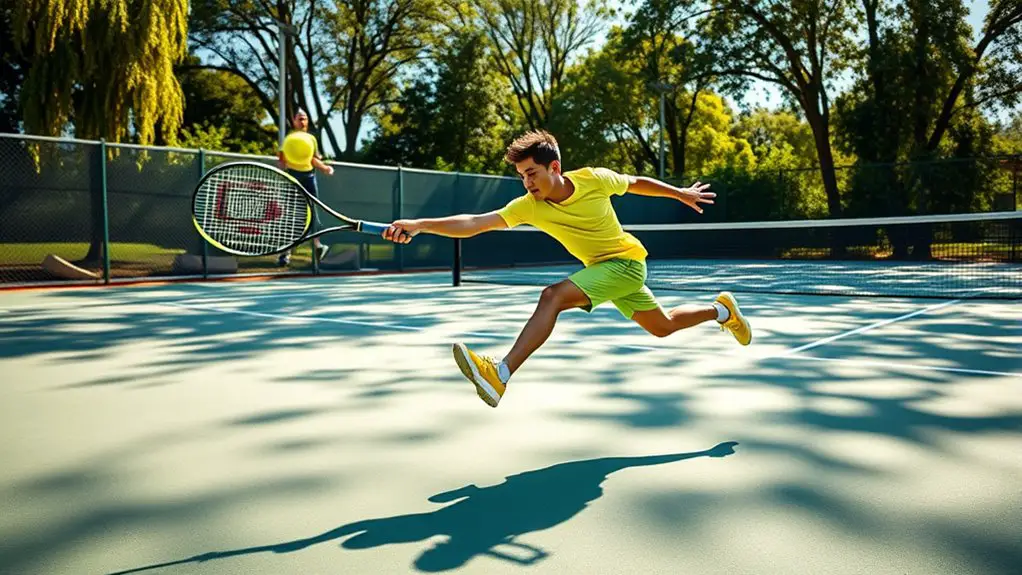To increase your grip strength for racquet sports, incorporate exercises like hand squeezing with a ball, finger curls with dumbbells, and towel wringing. Use tools like grip trainers and hand grippers to build strength. Aim for training two to three times a week, letting your muscles recover in between. Always warm up your hands and wrists, and listen to your body to avoid injuries. There's more effective guidance on optimizing your grip strength.
Understanding Grip Strength and Its Importance in Racquet Sports
Grip strength is an indispensable element in racquet sports, impacting everything from your serve to your volleys. It's more than just holding your racket; it's about how well you can control your movements and respond to your opponent. When you understand the muscle anatomy involved, you realize how essential your forearm and hand muscles are in generating power and precision.
Stronger grip strength translates to significant performance benefits. You'll find that your swings are more powerful, your serves more accurate, and your overall game becomes more fluid. Plus, a solid grip can help prevent injuries, allowing you to play freely and with confidence. When you harness this strength, you're not just enhancing your skills; you're embracing the freedom to express yourself on the court. So, building that grip strength is important for releasing your full potential in racquet sports. Developing grip strength also improves stability and coordination, which are vital for executing complex shots effectively.
Effective Exercises to Enhance Grip Strength
To enhance your grip strength effectively, incorporating targeted exercises into your training routine is essential. Start with hand squeezing; simply grab a tennis ball or a stress ball and squeeze it tightly for several seconds. Repeat this exercise for multiple sets. This not only strengthens your grip but also improves your endurance during matches.
Next, try finger curls. Hold a lightweight dumbbell in one hand and curl your fingers around it, lifting the weight using only your fingers. This exercise targets the muscles in your hands and forearms, which are vital for racquet sports.
Additionally, consider doing towel wringing—twist a wet towel as if you're trying to wring out water. This engages multiple grip muscles. By incorporating these exercises into your routine, you'll develop a powerful grip that can give you an edge on the court. Embrace these movements, and feel your grip strength soar! Also, ensure that you are focusing on proper hydration, as it helps maintain muscle function during your training sessions.
Tools and Equipment for Grip Strength Training
When aiming to enhance your grip strength, utilizing the right tools and equipment can make a significant difference. Grip trainers are fantastic for building endurance and strength, allowing you to customize resistance levels to suit your needs. They're compact and perfect for on-the-go training, so you won't be tied down to a gym.
Hand grippers are another essential piece of equipment; they're simple yet effective. You can use them while watching TV or even during breaks at work, giving you the freedom to integrate training into your daily life.
Consider adding a stress ball or a foam roller to your routine as well. These versatile tools can help improve grip strength without the need for heavy equipment. Remember, the key is consistency, so pick tools you enjoy using, and you'll find yourself crushing it on the court in no time.
Incorporating Grip Strength Training Into Your Routine
Although it might seem intimidating, incorporating grip strength training into your routine is easier than you think. Start small and focus on different grip variations to keep things interesting. Aim for a training frequency of two to three times a week, allowing your muscles to recover while building strength.
Here's a simple plan to get you started:
| Day | Grip Variation |
|---|---|
| Monday | Farmer's Walk |
| Wednesday | Plate Pinches |
| Friday | Wrist Curls |
| Optional Day | Towel Twists |
Tips for Maintaining Grip Strength and Preventing Injuries
Here are some tips for effective grip maintenance and injury prevention:
- Warm-Up Properly: Before hitting the court, take a few minutes to warm up your hands and wrists. Simple stretches and mobility exercises can prepare your muscles for action.
- Balance Your Workouts: Don't just focus on grip strength; incorporate exercises that strengthen your forearms and wrists. This balance reduces the risk of overuse injuries and keeps you feeling free.
- Listen to Your Body: Pay attention to any discomfort or fatigue. If you feel pain, take a break. Ignoring your body's signals can lead to injuries that sideline you. Additionally, ensure you include dynamic stretching in your warm-up routine, as it enhances blood flow and flexibility, ultimately reducing the risk of injuries.
Frequently Asked Questions
How Long Does It Take to See Improvements in Grip Strength?
You might think improvement takes forever, but that's not the case! Typically, you can start seeing grip strength gains within just a few weeks of consistent training. It's essential to track your progress, though, as that keeps you motivated and helps you stay focused. With the right exercises, you'll notice changes in your grip strength, giving you the freedom to enjoy your activities even more. Just stay patient and committed to the process!
Can Diet Affect Grip Strength and Overall Performance?
Yes, your diet can definitely affect grip strength and overall performance. Nutrient timing is vital—eating the right foods before and after workouts can enhance your strength gains. Plus, staying hydrated is essential; your hydration levels impact muscle function and endurance. When you fuel your body properly, you'll feel more powerful and free on the court. So, pay attention to what you eat and drink to maximize your grip and performance.
Are There Specific Warm-Up Exercises for Grip Strength?
You've felt that tug of frustration when your grip just isn't strong enough, haven't you? To warm up effectively, try incorporating dynamic stretches that engage your hands and wrists. Using resistance bands can be a game-changer; just a few minutes of band pulls and extensions can ignite your grip strength. Embrace these movements, and you'll feel that liberating sense of power and control, ready to tackle any challenge that comes your way.
What Are Common Mistakes in Grip Strength Training?
When it comes to grip strength training, you might make a few common mistakes. First, not varying your grip exercises can limit progress, so mix them up. Also, don't underestimate the importance of training frequency; too much or too little can hinder your gains. Finally, neglecting rest and recovery can lead to fatigue and injury. Stay mindful of these pitfalls to guarantee you're maximizing your grip strength effectively and enjoying your training journey.
How Can Psychology Impact Grip Strength in Competition?
Imagine standing on the court, adrenaline pumping, with the crowd's energy fueling your every move. In competition, your grip strength isn't just physical; it's intertwined with your mental resilience. If you harness a competitive mindset, you can push through moments of doubt and fatigue. When you believe in your ability to perform, your grip feels tighter, your control sharper. Embrace that mental freedom, and watch how it transforms your game.
